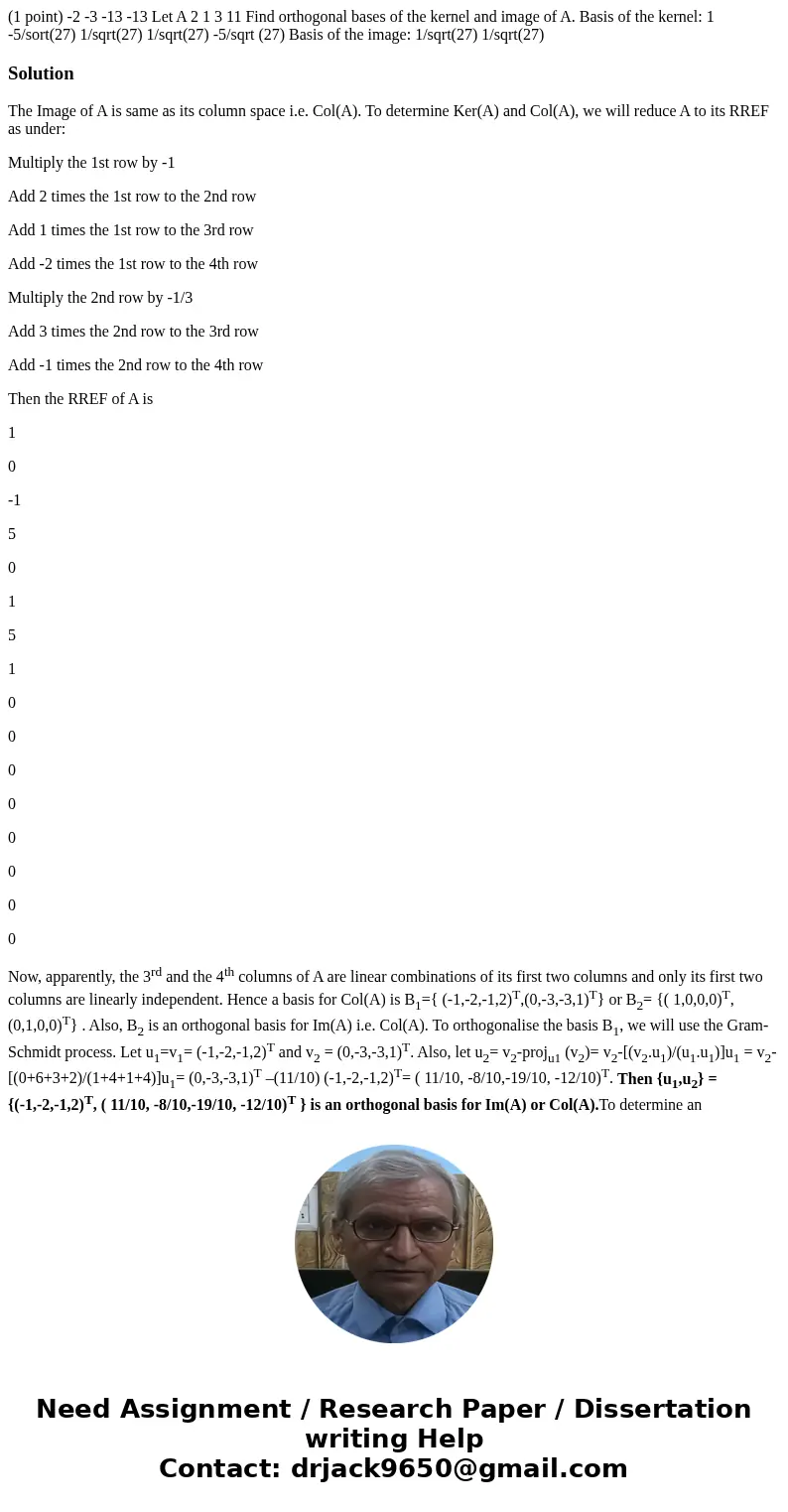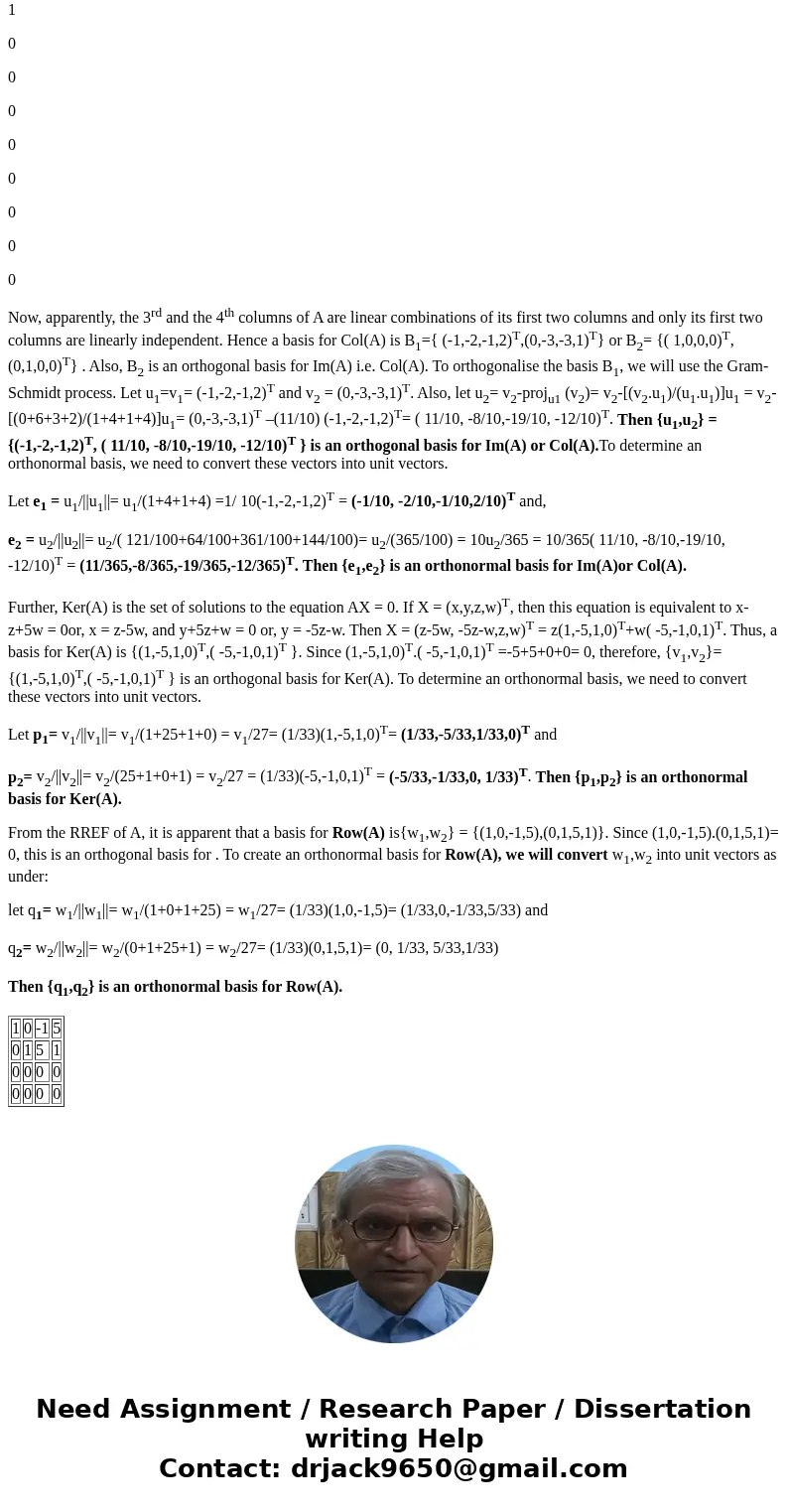1 point 2 3 13 13 Let A 2 1 3 11 Find orthogonal bases of th
Solution
The Image of A is same as its column space i.e. Col(A). To determine Ker(A) and Col(A), we will reduce A to its RREF as under:
Multiply the 1st row by -1
Add 2 times the 1st row to the 2nd row
Add 1 times the 1st row to the 3rd row
Add -2 times the 1st row to the 4th row
Multiply the 2nd row by -1/3
Add 3 times the 2nd row to the 3rd row
Add -1 times the 2nd row to the 4th row
Then the RREF of A is
1
0
-1
5
0
1
5
1
0
0
0
0
0
0
0
0
Now, apparently, the 3rd and the 4th columns of A are linear combinations of its first two columns and only its first two columns are linearly independent. Hence a basis for Col(A) is B1={ (-1,-2,-1,2)T,(0,-3,-3,1)T} or B2= {( 1,0,0,0)T, (0,1,0,0)T} . Also, B2 is an orthogonal basis for Im(A) i.e. Col(A). To orthogonalise the basis B1, we will use the Gram-Schmidt process. Let u1=v1= (-1,-2,-1,2)T and v2 = (0,-3,-3,1)T. Also, let u2= v2-proju1 (v2)= v2-[(v2.u1)/(u1.u1)]u1 = v2-[(0+6+3+2)/(1+4+1+4)]u1= (0,-3,-3,1)T –(11/10) (-1,-2,-1,2)T= ( 11/10, -8/10,-19/10, -12/10)T. Then {u1,u2} = {(-1,-2,-1,2)T, ( 11/10, -8/10,-19/10, -12/10)T } is an orthogonal basis for Im(A) or Col(A).To determine an orthonormal basis, we need to convert these vectors into unit vectors.
Let e1 = u1/||u1||= u1/(1+4+1+4) =1/ 10(-1,-2,-1,2)T = (-1/10, -2/10,-1/10,2/10)T and,
e2 = u2/||u2||= u2/( 121/100+64/100+361/100+144/100)= u2/(365/100) = 10u2/365 = 10/365( 11/10, -8/10,-19/10, -12/10)T = (11/365,-8/365,-19/365,-12/365)T. Then {e1,e2} is an orthonormal basis for Im(A)or Col(A).
Further, Ker(A) is the set of solutions to the equation AX = 0. If X = (x,y,z,w)T, then this equation is equivalent to x-z+5w = 0or, x = z-5w, and y+5z+w = 0 or, y = -5z-w. Then X = (z-5w, -5z-w,z,w)T = z(1,-5,1,0)T+w( -5,-1,0,1)T. Thus, a basis for Ker(A) is {(1,-5,1,0)T,( -5,-1,0,1)T }. Since (1,-5,1,0)T.( -5,-1,0,1)T =-5+5+0+0= 0, therefore, {v1,v2}= {(1,-5,1,0)T,( -5,-1,0,1)T } is an orthogonal basis for Ker(A). To determine an orthonormal basis, we need to convert these vectors into unit vectors.
Let p1= v1/||v1||= v1/(1+25+1+0) = v1/27= (1/33)(1,-5,1,0)T= (1/33,-5/33,1/33,0)T and
p2= v2/||v2||= v2/(25+1+0+1) = v2/27 = (1/33)(-5,-1,0,1)T = (-5/33,-1/33,0, 1/33)T. Then {p1,p2} is an orthonormal basis for Ker(A).
From the RREF of A, it is apparent that a basis for Row(A) is{w1,w2} = {(1,0,-1,5),(0,1,5,1)}. Since (1,0,-1,5).(0,1,5,1)= 0, this is an orthogonal basis for . To create an orthonormal basis for Row(A), we will convert w1,w2 into unit vectors as under:
let q1= w1/||w1||= w1/(1+0+1+25) = w1/27= (1/33)(1,0,-1,5)= (1/33,0,-1/33,5/33) and
q2= w2/||w2||= w2/(0+1+25+1) = w2/27= (1/33)(0,1,5,1)= (0, 1/33, 5/33,1/33)
Then {q1,q2} is an orthonormal basis for Row(A).
| 1 | 0 | -1 | 5 |
| 0 | 1 | 5 | 1 |
| 0 | 0 | 0 | 0 |
| 0 | 0 | 0 | 0 |


 Homework Sourse
Homework Sourse